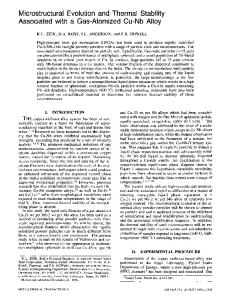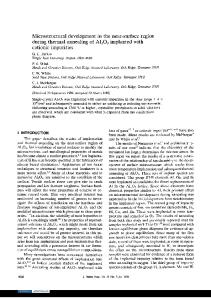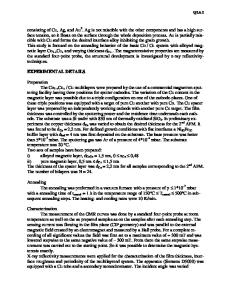Microstructural Evolution of Cu/Ta/GaAs Multilayers with Thermal Annealing
- PDF / 392,142 Bytes
- 6 Pages / 612 x 792 pts (letter) Page_size
- 7 Downloads / 332 Views
B7.2.1
Microstructural Evolution of Cu/Ta/GaAs Multilayers with Thermal Annealing Wei-Cheng Wu, Chang-You Chen, Chen-Shih Lee, Edward Yi Chang, Li Chang Department of Materials Science and Engineering, National Chiao Tung University, Hsinchu, Tawain 300, Republic of China ABSTRACT Copper metallization for GaAs was evaluated by using Cu/Ta/GaAs multilayers for its thermal stability. A thin Ta layer of 30 nm thickness was sputtered on the GaAs substrate as the diffusion barrier before copper film metallization. As judged from the results of sheet resistance, X-ray diffraction, Auger electron spectroscopy and transmission electron microscopy, the Cu/Ta films on GaAs were very stable up to 500 °C without Cu migration into GaAs. After 550 °C annealing, the interfacial mixing of Ta with GaAs substrate occurred, resulting in the formation of TaGa2 and TaAs2, and the diffusion of Ga and As through the Ta layer formed the Cu3Ga and Cu3As phases at the Cu/Ta interface. After 600 °C annealing, the reaction of GaAs with Ta and Cu formed TaAs and Cu3Ga, as a result of Cu migration and interfacial instability. INTRODUCTION The quick development of high-frequency wireless communication industry makes GaAs integrated circuits become the focus worldwide. Traditionally, GaAs field-effect transistors (FET’s) use Ti as adhesion layer, and Au as the metallization metal. The use of copper as the metallization metal has the following advantages over gold: lower resistivity, higher thermal conductivity and lower cost. If Au is replaced with Cu for front-side transmission lines, the electrical conductivity can be improved to increase the speed. It is well known that copper diffuses very fast into Si without any diffusion barrier. Copper also diffuses very fast into GaAs [1-4]. Since copper is a deep acceptor for GaAs [5,6], this causes degradation of electrical properties of the GaAs devices. It is worthwhile to study the feasibility of Cu metallization on GaAs devices with Ta barrier. The thermal stability between the Cu/Ta/GaAs multilayers for backside and transmission lines metallization has hardly been studied. We have reported that a sputtered Ta film effectively prevented the interaction of Cu and GaAs after anneals at temperatures up to 500 oC [7]. In this study we extend the previous works to characterize microstructural evolution of Cu/Ta/GaAs with thermal annealing temperatures.
B7.2.2
EXPERIMENTAL DETAILS Before metal films deposition, the backside of 3-inch GaAs (100) substrates were deposited with 100 nm Si3N4 to avoid out-diffusion of As gas during annealing at higher temperatures. The metal films were deposited by sputtering in a multi-target dc magnetron sputtering system. A Ta film of 30 nm thickness was first sputtered onto the GaAs substrate, then a 100 nm Cu film and a 10 nm tantalum nitride films were subsequently sputtered onto the Ta film without breaking vacuum. The tantalum nitride film which served as a protective layer to prevent oxidation of the copper layer was deposited by reactive sputtering of Ta in the N
Data Loading...











